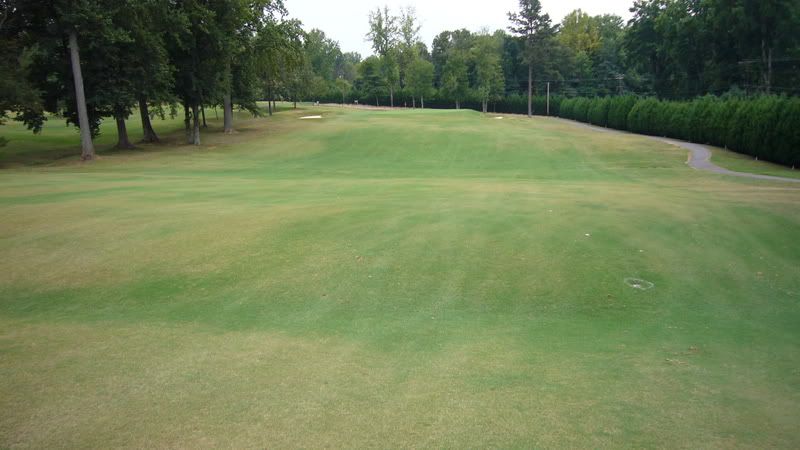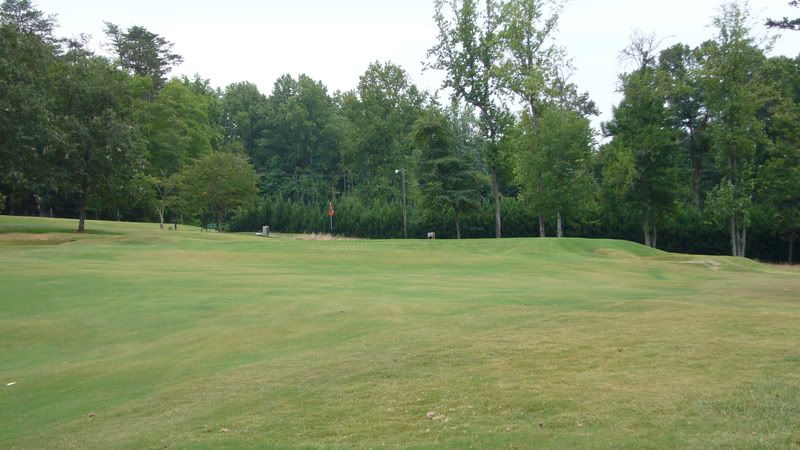Josh, it looks like I've played the "wrong" Hyde Park by Ross.
Just to keep it real, I'll throw in the 7th at Mimosa Hills. Actually I'll just mail it in by copy-pasting a post made a while back:
The task off the tee is to surmount the ridge shown in the picture below. From the back tee, the ridge line is roughly 250 yards out, maybe a little farther. Ideally, the drive comes to rest somewhere around the right-third of the fairway. This offers a better angle into the green. But this ridge cants to right. Under firm and fast summertime conditions, a drive high up the ridge to the left still may hang up, complicating matters enormously. But a little too far to the right quickly becomes a lot too far to the right.
7 tee
The ridge seen from the tee hides a second, lower ridge put to brilliant use by Ross. Together, the first and second ridges form a sideways "half-pipe." In a match between golfers of unequal length, this pipe compresses the distance between their drives: the first ridge provides a turbo boost, the second a turbo brake.
A golfer who nails his tee shot is likely to face a second shot of similar length as the golfer who slightly misses his or who is not quite as long off the tee. The technology proofing is provided by the second ridge, which requires the energy of something like a 315-plus yard drive, which under firm-and-fast conditions may not be as daunting as appears but nevertheless is not within the capabilities of 99 percent of golfers. Not sure I'd want a design to do this for many holes, but it is nice to see at least one hole that puts golfers on relatively equal footing to test (a) their woods / long irons and (b) their nerve.
7 fairway, showing the second, turbo-brake ridge
Time for a decision. Does the golfer go for the green, which like Prairie Dunes's 5th is benched into a hillside with a ruinous false front? From the base of the second ridge, the shot is something like 210 yards.
Why not have a go? Because a third ridge, its top lopped off to present a left-to-right sloping plateau, will propel sharply to the right any shots hit short of the green. Lurking to the right is out of bounds -- with a paved cart path ready to supply the final indignity of shooing a dying shot beyond the white stakes.
This slope has an amazing and very demoralizing efficiency at transferring the ball's kinetic energy into, well, a bush.
Another, closer look at the approach to 7: note from left to right the slope directly in front of green (the "tan line" follows the slope), the cart path, the OB stakes, the bushes
So the play is to hit some sort of draw into the slope. Two complications arise: first, the ball lies beneath the golfer's feet, and, second, over-executing this shot produces a highly-challenging, downhill pitch (or bunker shot) to a green running away from the golfer.
Laying up however offers little respite. From this plateau in front of the green, the golfer must either pitch all the way to the green or chip all the way up; any shots failing the green may well return
past his feet owing to the sharp false front plus aforementioned third ridge. (When this happens the members say they've been "Rossed.")
A hole front left as shown in the picture below is very difficult.
7 green: the third ridge runs from 5 to 40 yards short of the green and sharply from left to right
And there you have it. A 493-yard par 5 that under firm-and-fast conditions pretty much will guarantee a legitimate chance to go in two; the half-pipe pretty much ensures, under virtually all conditions and from most tees, that shot will be somewhere between 205-225 yards. The golfer who chooses to go for it must propel the ball all the way, playing up to the left if he needs use of the ground at all, risking bunkers left and right and a steep drop off long if he tries the all-carry route.
4s to 7s all on offer. Box of chocolates hole.